|
|
 On Chesapeake Country’s 2001-2002 Theater Season On Chesapeake Country’s 2001-2002 Theater Season
by Carol Glover
It takes the talents of lighting designers Garrett Hyde, left, and Pete Dursin, right, plus the overall plan by set designer Lynne Wilson, center, to create the magical scenes like that from Into the Woods, below.
For these few nights, hours have been invested in shopping for fabric, studying script, hammering and painting, working sound and light boards to create just the right mood.
Autumn makes its appearance in Chesapeake Country: Waters turn crystal clear, crowds disperse and days shorten.
The theater season makes its appearance in Chesapeake Bay Country: Directors study scripts, volunteers man box office phones, behind-the-scenes artists dust off treasures and theater companies return.
All summer while most of us were boating, swimming, fishing and enjoying the sunny days, community theater directors have been poring over scripts, imagining, visualizing, to create our indoor entertainment.
Inside, as we sit entranced, bustle and sometimes chaos erupts behind the scenes. For these few nights, hours have been invested in shopping for fabric, studying script, hammering and painting, working sound and light boards to create just the right mood.
“For every six actors on stage, there are 25 workers off stage,” says Lin Mascia, producer for Bowie Community Theater. “What the audience sees is the tip of the iceberg.”
Each company toils endless hours to create stage magic — and it must be different for each production. Producer, director, lighting director, set designer and choreographer collaborate to capture the audience in their spell.
When it all comes together, says Twin Beach Players’ Sid Curl, “the result is exciting.”
 In the Beginning Was the Director In the Beginning Was the Director
The director shares with the technical staff what he is
seeing in his artistic mind.
— Estelle Miller, President: Bowie Community Theatre
2nd Star Productions scenic artist Lynne Wilson, left, and set designer Jane Wingard mop and brush paint onto the wooden frames used in stage sets. photo by Amanda Lofton
September is a busy time for Bowie Community Theatre’s play selection committee. The new season is in full swing and they’re already thinking about the 2002-2003 season. Board members and other interested company members come to the first meeting with synopses of any play they’d like to propose, whether they’ve seen it done or only heard about it. Directors also reach out to the theater company with suggestions of works they’ve done or would particularly like to do. They will meet now and again in January 2002 to be finished choosing their 2002-2003 season by May.
The committee goes through each play with specific criteria in mind: Will it do well in our theater and on this stage? How big is the cast? Is the set set-able — not too intricate or outlandish? Will our patrons enjoy it? Is it too risqué? Is it challenging enough to bring out good actors?
Whether good actors want to be in it is an important criterion to Miller. “We want actors, when the play selection is announced, to say, ‘This is such a great play.’
“This process is the most serious thing you do all year because it’s your season. The company’s finances depend on it,” she explains.
The committee rates the plays, whittling the number down to seven, from which the board picks three.
Then the fun begins. The search for three directors is on. Local directors are called to see if they are available and interested. Meeting with the prospective directors, the committee can agree, disagree and compromise on the concept each presents for the production. And they can judge whether a director’s skills fit the play.
For Bowie’s season, which features two British plays, Black Coffee and The Importance of Being Earnest, the perfect choices were Bob Sams and Frank Moorman. Both have lots of expertise with British comedy. They know the British accents needed for authenticity. And they are able to teach those accents to the actors.
Also staging their plays at Bowie Playhouse is 2nd Star Productions. There, director Charles W. Maloney is a master at comedy. Having directed the farce Noises Off with great success, he’ll be returning this season, bringing his flair for hijinks to Moon Over Buffalo.
The director joins with many collaborators to realize a play. From the first meeting with the set designer, the director brings a pretty good idea of how the set should look. Next come meetings with sound, light, and prop people, the producer and the costume designer.
“This is when,” says 2nd Star’s Jane Wingard, “the company finds out what the director wants. He puts in his two cents about the plot, the costumes, everything.” Then all go off to work their bit of magic.
While the director takes care of up-front business, the producer toils behind scenes.
And the Theater Was Without Form and Void
The producer shows up with lists of things to do.
— Bowie Community Theatre’s Miller
As well as a director, every show has a producer, the person who takes charge of the behind-the-scenes coordination. The producer’s work begins as soon as the play is selected. During the actors’ first read-through, the producer shows up with scads of paper containing schedules galore. At Bowie, for example, packets are prepared for each actor, heaped with page after page of everything they need to know: production schedule, costume fittings, directions to the theater, phone numbers.
At the production meeting, while the director works out how the play will look, the producer introduces reality, specifically the budget. The producer must also recruit volunteers for box office, ushering, program design and advertising.
“When I’m in the throes of the show, I’m working three hours a day for a six-week period in addition to rehearsal time three nights a week,” says producer Lin Mascia while preparing for Black Coffee, Bowie’s opening production.
Why would Mascia, in addition to being a freelance talent and production coordinator, volunteer for this huge job? “Theater is my passion,” she says. “Seeing the finished product is a thrill. WOW is how I describe it.”
Let There Be Light
At 2nd Star, Garrett R. Hyde works with the director and set designer to carry out the mood and feel of the production through light.
— Jane Wingard, co-founder of 2nd Star Productions
Hyde is a busy man. He is employed as the lighting designer by the City of Bowie for Bowie Playhouse. By moonlight, he designs lighting for a number of other community theater groups including Chesapeake Music Hall.
He and his kind go to work to create the right light for each of a play’s scenes, explains Wingard, “once the set is up and in place and he sees the colors.”
“When you see the play,” she says, without your even knowing, light will have as much impact as the set itself.”
The mood the director envisions is illuminated by a company’s lighting experts. So directors bring their dreams to Hyde. ‘I want it to look like daylight here,’ they tell him. Or ‘I want a blackout here.’
Sherry Kay Anderson, owner of Chesapeake Music Hall, works with Hyde frequently. “I’ll explain the set. Hyde already knows the limits of the Music Hall, how it’s round and has a low ceiling. He knows what works.”
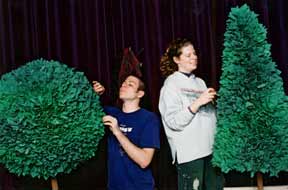 The Stage Brings Forth Abundance The Stage Brings Forth Abundance
The set designer decides, ‘We can do that, it will fit the space.’
— 2nd Star’s Wingard
Dave Johney and Chrissie Taylor prepare trees and bushes for Moonlight Troupers’ On the Razzle. photo courtesy of Moonlight Troupers
Community theater set designers know most of the limitations of the area’s theaters. Colonial Players needs sets that work in the round; Chesapeake Music Hall has a three-quarters thrust into the audience.
With the theater’s physical spaces in mind, the set designer searches through many resources to spark ideas: the Internet, other designers’ works, concepts from the director and old photographs of previous productions.
One pro on the scene is Sid Curl, of Twin Beach Players, who traveled the East Coast designing sets before settling in as technical director at Maryland Hall for the Creative Arts.
2nd Star Productions has a leg up over the other community theaters. Three of its permanent staff are scenic designers. Their real-life work involves creating sets for theme parks, touring musicians, opera and ballet companies.
Lynne Wilson, who designs for 2nd Star, draws the set to scale, penciling in the coloring. She has a model of Bowie Playhouse so all the pieces fit. The set is painted at co-founder John Guyton’s National Themesworks Company and transported to the theater, where it is screwed together.
Wilson has spent summer working on the set for 2nd Star’s opener, The Sound of Music, where rooms, gardens the abbey and even a mountainside will be raised and lowered into place with a fly system of pulleys and weights.
Karel Richardson doesn’t have the luxury of time when he designs for Chesapeake Music Hall. The set is constructed a week before opening because the preceding show is still running. He is so familiar with the Music Hall that, as he talks with Sherry Kay Anderson, he can tell right away if her ideas are possible.
The Moonlight Troupers at Anne Arundel Community College is a teaching company where students get to learn and experiment. For their upcoming Annie Get Your Gun, Bob Kauffman, head of the Performing Arts Department is designing the sets. “This production has all the challenges of a Wild, Wild West show,” he says.
Among the scenes he hopes to create are hotel facade, ballroom and ship’s deck. “The students will build the set as part of their course work,” says Kauffman.
Continuing the mood and feel of the production are the costumes.
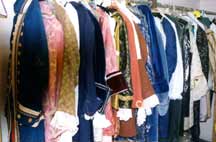 With Coats and Skins They Were Clothed With Coats and Skins They Were Clothed
At Chesapeake Music hall, we have 150 linear feet of stored costumes.
— Sherry Kay Anderson
For her Music Hall shows, Sherry Kay Anderson is a couturier, milliner and seamstress. With the help of Judi Drinks, she builds the costumes she needs. “I go to Value Village, and for $1.50 I’ll buy a prom dress. I’ll cannibalize it, take the top of one dress and attach it to another or add petticoats. A few tweaks here and there, an under sleeve, an inlay, and I’ve got a great costume.”
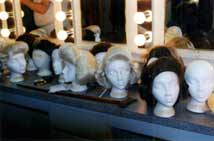 Frugality is the by-word at Bowie Community Theater, as well. The costume designer shops at thrift stores and asks actors, “Do you have this in your closet?” Frugality is the by-word at Bowie Community Theater, as well. The costume designer shops at thrift stores and asks actors, “Do you have this in your closet?”
2nd Star, known for its opulent sets, carries luxury over to its costumes. Many are rented from Ben Morelli in Philadelphia, who does Broadway and Disney. Sometimes fancy stuff comes from the Annapolis Opera Company. “We build lead costumes,” says Wingard, “and sometimes the actors have had costumes made for themselves. We spend $16,000 to $20,000 for a musical.”
Musicals have the added element of dance, which adds a choreographer to the mix.
Moving Creatures that Hath Life
I pay attention to everything that has to do with dance.
— Sherry Kay Anderson
Anderson’s company calls her dance routines “Sherryography.” Says she: “I’ve learned what works and what doesn’t. It needs to feel right with the music and the audience has to like it.” Many actors are not dancers, so a choreographer needs to work with different levels of talent. Those with greater dance ability get more intricate steps and routines. The actors with no dance ability get simple, repetitive steps.
For 2nd Star’s not yet chosen early summer show Talent Machine’s Vickie Smith will bring the dance routines to a very high level. If you’ve seen Talent Machine’s shows you’ll want to see Smith’s work for 2nd Star.
And the Theater Brings Forth Abundantly
To get into a play, you’ve got to get to its theater.
Walk through the woods beneath towering trees while leaves crunch beneath your feet. Reach a gray wooden building that blends with nature. This is the Bowie Playhouse, home to Bowie Community Theatre and 2nd
Star Productions.
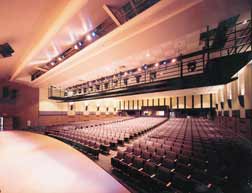 Northern Anne Arundel County’s new Chesapeake Center for the Creative Arts boasts a state-of-the-art theater and stage. photo courtesy of Chesapeake Center for the Creative Arts Northern Anne Arundel County’s new Chesapeake Center for the Creative Arts boasts a state-of-the-art theater and stage. photo courtesy of Chesapeake Center for the Creative Arts
Drive to Brooklyn Park. Enter new, expansive, technically up-to-date Chesapeake Center for the Creative Arts, home to Pasadena Theatre Company and Second Stage Productions.
Stroll in the heart of downtown Annapolis. Enjoy the intimacy of theater in the round at the arena stage of Colonial Players.
Add to your evening’s pleasure. Dine with linen table cloths, wine goblets and aspiring young actors as wait staff at Chesapeake Music Hall.
Go back to college setting. The box office and lobby at Pascal Center for the Performing arts are part of a theater laboratory for student thespians of the Moonlight Troupers at Anne Arundel Community College.
Stay on your toes. Peruse the newspapers and roadside signs to find Twin Beach Players’ next venue.
Dine with friends and neighbors as you contribute to worthy community organizations. Alumni Players and Patuxent Playhouse raise money for charity through their productions.
Gaze upwards at clouds and twinkling stars. If only Annapolis Summer Garden Theatre played an autumn season.
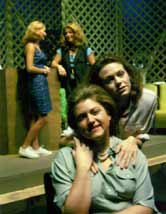 Finis Finis
Sets don’t have to be expensive. Laticework and borrowed hair dryers set the stage for Twin Beach Players’ Steel Magnolias. photo courtesy ofTwin Beach Players
While most of us basked in a glorious summer, our community theater companies have been busy as squirrels getting ready for winter. Putting all the pieces together, they’re preparing to weave their magic. We’re lucky. We’ve had the fun of summer. Now we’ll have the thrill and joy of watching great shows right here in our own backyard.
At the Theater: 2001-2002
Alumni Players: 410/326-4739
January, 2002 — See How They Run; Booked at Our Lady Star of the Sea Catholic Church, Solomons.
Annapolis Summer Garden Theatre: 410/268-9212
2002 season TBA.
Bowie Community Theatre: at Bowie Playhouse; Rt. 3 South of Rt. 50 at White Marsh Park; 301/805-0219.
Oct. 5–20 — Black Coffee by Agatha Christie. Detective Hercule Poirot makes his only appearance in a play when eminent scientist Sir Claud Amory is murdered after calling Poirot in fear that someone is trying to steal his secret atomic formula.
Jan. 25–Feb. 9 — Romantic Comedy by Bernard Slade. Broadway playwright faces marriage and loss of his collaborator when aspiring female playwright enters the picture.
April 26–May 11 — The Importance of Being Earnest by Oscar Wilde. English aristocracy take a turn at wit before the turn of the 20th century.
Chesapeake Music Hall: 339 Busch’s Frontage Rd., Annapolis; 800/406-0306.
Sept. 21–Nov. 18 — Showboat. The showboat Cotton Blossom provides the backdrop for stories of love and music of the Mississippi.
Nov. 24–Dec. 23 — A Christmas Carol. Scrooge returns.
Jan. 5–26 — Gotta Sing Gotta Dance. Review show of the best of Broadway from seven years of Music Hall shows; many performers return.
Feb. 2–April 6 — Hello Dolly. Dolly Levi tries her hand at matchmaking as she sets out to find a wife for wealthy Horace Vandergelder.
April 13–June 29 — The Sound of Music. Postulant Maria comes into the lives of the von Trapp family, winning over the kids as well as the captain.
July 6–Aug. 31 — Copacabana. Barry Manilow’s music sets the tone for this high-energy look at nightclub life.
Colonial Players: 108 East St., Annapolis; 410/268-7373.
Sept. 29 — To Gillian on Her 37th Birthday by Michael Brady. A family gathers at a beach house to celebrate the birthday of a deceased and beloved wife.
Oct. 19–Nov. 17 — Hay Fever by Noel Coward. A classic filled with Coward humor as an English family with only one guest room entertains weekend guests
Jan. 11–Feb. 9 — The Trip to Bountiful by Horton Foote. An elderly lady makes a last journey to her home in spite of family objections.
March 1–30 — Is There Life After High School? by Ralph Keys. A musical look at high school reunions.
April 26–May 25 — Playboy of the Western World by John Synge. A poetic look at rural Ireland and the heroism of its people.
Moonlight Troupers: performing at Pascal Center Anne Arundel Community College; 410/777-2457.
Nov. 9–18 — Annie Get Your Gun by Herbert and Dorothy Fields; Irving Berlin. The story of Annie Oakley and Frank Butler in America’s Wild West.
Spring 2002 — Children’s show TBA.
Pasadena Theatre Company: performing at Chesapeake Center for the Creative Arts, Brooklyn Park; 410/636-6597; www.pasadena theatrecompany.com; www.chesapeakearts.org.
Sept. 14–30 — Plaza Suite by Neil Simon. Three playlets of three couples who use the same suite, at different times of course, at the Plaza Hotel. Typical Simon humorous look at marriage and relationships.
Nov. 23–25 — It’s a Wonderful Life by James W. Rodgers. The fifth year of a holiday show of magic and renewal.
April 5–21 — The King and I by Rodgers and Hammerstein. The King of Siam, governess Anna and the children in the heartwarming musical of life at the royal court.
Patuxent Playhouse: 410/326-1401
Oct. 21 at Elks Lodge, Prince Frederick
Oct. 28, Nov. 2 at Nook & Monks, Leonardtown
Nov. 9 — Spiral Staircase
Dec. 7, 8 at Calvert Marine Museum — Gift of the Magi
May — South Pacific by Rodgers, Hammerstein; Logan. James Michener’s Tales of the South Pacific set to music.
Second Stage: at Chesapeake Center for the Creative Arts, Brooklyn Park; 410/636-6597; www.chesapeakearts.org
Oct. 5–20 — South Pacific
Feb. 15–24, March 1,2 — Born Yesterday by Garson Kanin. The dumb blonde mistress gets a virile young tutor and learns some of life’s important lessons.
May 3–18 — The Last Night of Ballyho by Alfred Uhry.
2nd Star Productions: performing at Bowie Playhouse; 301/858-7245; www.2indiestarproductions.com.
Nov. 2–Dec. 1 — The Sound of Music by Rodgers and Hammerstein.
March 1–23 — Moon Over Buffalo by Ken Ludwig.
May 31–June 29 — Summer musical TBA.
Twin Beach Players
Holiday Season — Little Women.
Copyright 2001
Bay Weekly
|